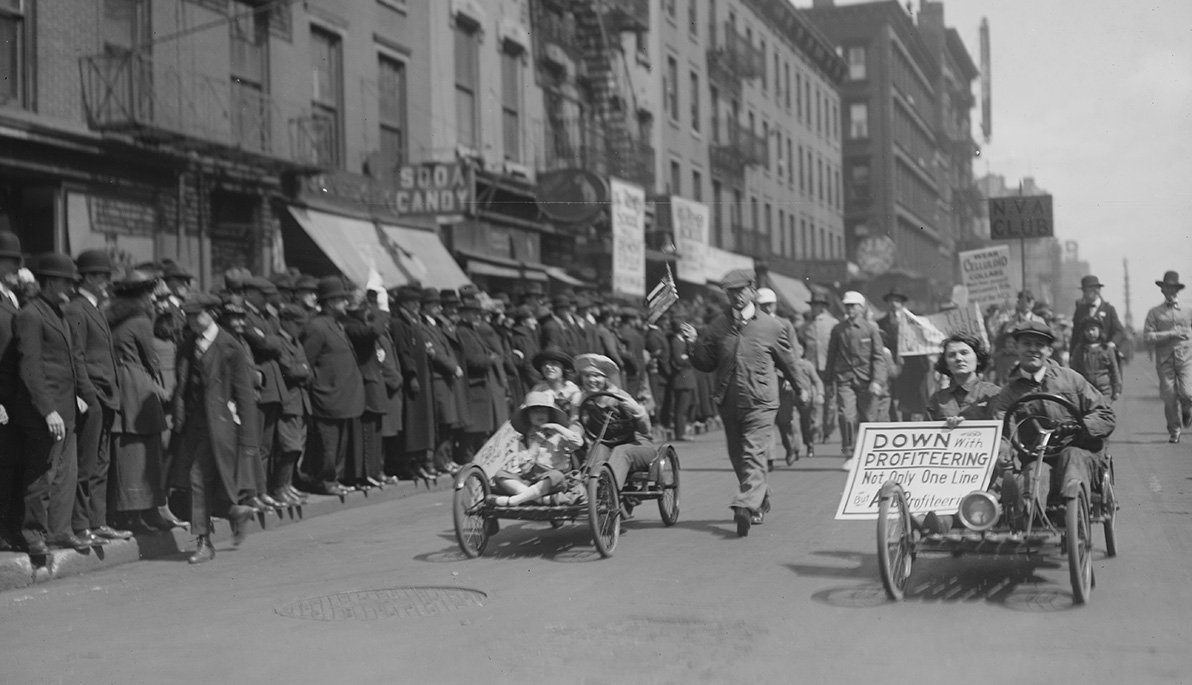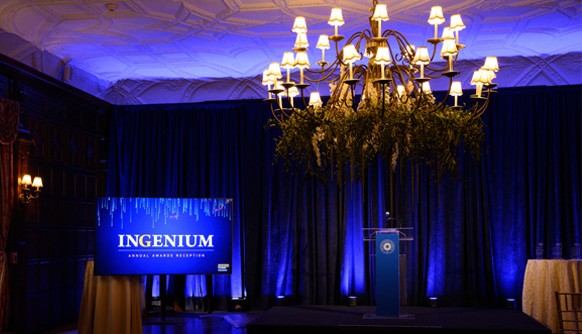News
Another Look at New York Circa 1920
December 3, 2020
Pictured: Marchers protesting the high cost of living at the Overalls Parade.
Earlier this year, Jonathan Goldman, Ph.D., professor of English, launched the website, New York 1920, 100 Years Ago Today: When We Became Modern, a project made possible through an Institutional Support of Research and Creativity (ISRC) grant. Each day, he posts an interesting factoid about the city, like the marriage of Zelda Sayer to F. Scott Fitzgerald; marchers protesting the high cost of living at the Overalls Parade, which was led by denim-clad elephants on loan from the Ringling Brothers and Barnum and Bailey Circus; and bathing suits on sale at local department stores.
“I wanted to use my familiarity with the period to understand New York City itself better,” Goldman says about his motivation for the project that targets enthusiasts of New York City history and nostalgia buffs, among others. “Once I started researching, by perusing historical documents, letters, archives, and assets that have been digitized, I found parallels and connections between 1920 and current times that can help us navigate our world better, and understand our own moment.”
The Box recently chatted with Goldman to catch up on the project since its launch and to learn more about what readers can expect for the rest of the year as well as when the calendar page turns to 2021.
We are nearing the end of 2020, the anniversary of 100 years ago today that your website about New York history commemorates. Looking back, what are some of the most significant anniversaries you chronicled, and why?
Of course, there are the big historical moments: the passing of women’s right to vote nationwide (for white women anyway), the Red Scare, Marcus Garvey’s Pan-African Conference, Prohibition, the first commercial blues recording (Mamie Smith’s “Crazy Blues”). Big names were generating or consolidating their legacies: Babe Ruth, W.E.B. Du Bois, Edith Wharton, Margaret Sanger, Franklin Delano Roosevelt, Dorothy Parker, Arnold Rothstein, Jack Johnson.
Just as significant are the local histories that resonate with us today. In 1920, new subway tunnels opened; meanwhile the transit system was in deep financial trouble. New York passed a renters protection bill that put a moratorium on evictions and established an early version of rent control. Workers in numerous industries demanded better wages, sometimes striking, sometimes being met with violence. Immigration surged, resulting in dangerously cramped conditions at Ellis Island. The first traffic signal debuted (42nd and 5th Avenue). We featured 1920 New York City periodicals devoted to the city’s Black and Irish communities and others published in Arabic, Hungarian, Japanese, Ladino, Mandarin, Polish, Russian, and Yiddish for New Yorkers who read in those languages.
And then there are fascinating individual stories such as Catherine Allen, the first Black librarian at the New York Public Library, and the published poems of Luis Muñoz Marin (future Governor of Puerto Rico).
We covered the anniversaries of concerts, speeches, plays, art exhibits, and the publication of books, movies, and cartoon strips, plus sports results, new construction, restaurant menus, club meetings, etc. All the while we concentrated on underrepresented groups, the hidden stories of women, people of color, ethnic minorities, and queer/LGBTQ history.
Did the COVID-19 pandemic influence the content you shared as the year progressed? If so, how?
Oh yes. We adapted as 2020 unfolded. One of my favorite posts is about the New York City public school buildings designed by C.B.J. Snyder, who revolutionized school architecture with his use of natural light and ventilation. We posted that in September as schools were getting ready to open amid concerns of the virus spreading in poorly-ventilated schools (i.e., those that were built later). We also posted about COVID-related concerns such as quarantines, vaccines and anti-vaxxers (there was a big one in Brooklyn). The post about evictions was inspired by the rent crisis that COVID has engendered. The Spanish Flu that ravaged Europe and North America in 1918 made a brief return in early 1920, so we posted about that, including medical professionals teaching people to wash their hands. And, as a last example, for April Fool’s Day we posted a joke entry about a virus in the Corona neighborhood of Queens. (See what we did there?)
Do you plan to continue sharing this rich historical content about New York in 2021?
We are going to continue into 2021 and as long as we can!
When this project launched nearly one year ago, you noted that immigration was as big an issue in 1920 as in 2020. Now that 2020 is drawing to a close, what other issues are as big today as they were 100 years ago?
White supremacy. New York City was a hotbed of white supremacist thinking in 1920. Of course, the concept of “whiteness” in those days excluded, generally speaking, Italians, Southern/Eastern Europeans, and Jewish people.
In 2120, what will be the seminal historic events that will be commemorated when another scholar reflects on the past 100 years of New York history?
I won’t surprise you here: the COVID crisis and resulting exacerbation of economic inequality, and the #BLM marches and resulting police violence.



_Thumb.jpg)

